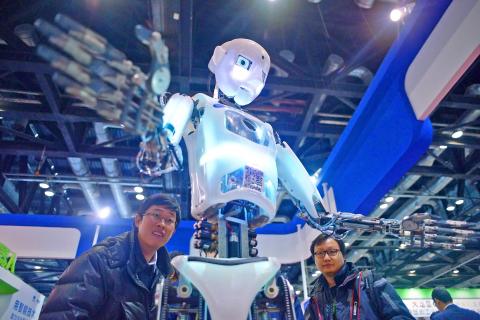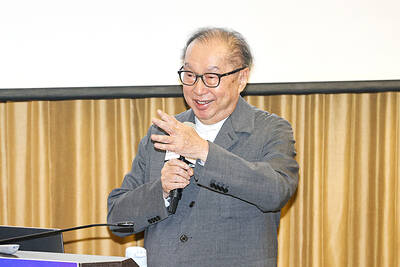In a martial artist’s white silk pyjamas, a man practiced taichi in harmony with a motorized arm at a Beijing exhibition showcasing a vision of robots with Chinese characteristics.
Vehicles with automated gun turrets sat alongside drink-serving karaoke machines at the World Robot Conference, as manufacturers sought new buyers for their jiqiren — “machine people” in Chinese.
The push has support at the highest levels of government.

Photo: AFP
Chinese President Xi Jinping (習近平) issued a letter of congratulations for the conference, and the industry is name-checked in the draft version of the country’s new five-year plan, the policy document that guides national economic development.
The world’s second-largest economy is already the leading market for industrial robots, accounting for one-quarter of global sales, according to the International Federation of Robotics.
However, executives at a conference roundtable said the real market opportunity was in service robots for the homes and offices of the world’s most populous country.
“There are now less than 100,000 robots in Chinese families, not including vacuum cleaners,” Canbot chief executive officer Liu Xuenan (劉雪楠) said.
In the future, said Yu Kai (余凱), the head of Horizon Robotics Inc (地平線機器人科技), China’s automated helpers will do everything from building cars to driving them, predicting that “each person might have 10 robots” — nearly 14 billion potential tin men at current population levels.
Robots have captured China’s imagination. From Transformers to Baymax, the star of Disney’s movie Big Hero 6, Chinese consumers have embraced robot heroes, spending hundreds of millions on related movies and merchandise.
In Chinese cities, businesses try to attract customers with robot waiters, cooks, and concierges. In the countryside, rural Da Vincis cobble together mechanical men from scrapyard junk.
A panel at the conference struggled with the question of how China would deal with the rise of artificially intelligent machines.
However, the transition from the world of fantasy and novelty to a real robot economy could be tricky, with the country’s technology still lagging far behind South Korea and Japan, the undisputed king of the robots.
China should have more realistic expectations for the near future, said Pinpin Zhu (朱頻頻), president of China’s voice-controlled service Xiao I Robot (小 i 机器人), which was involved in a patent dispute with US tech giant Apple linked to its personal digital assistant, Siri.
The country may descend from the peak of high expectations into a “trough of disillusionment,” said Zhu, who believes a smartphone-based “Planet of the Apps” is more likely than a world served by humanoid robots.
Some companies, he said, were focusing on more realistic products, such as “trying to modify the microwave oven into a robot that can fry eggs ... maybe it doesn’t look like a robot, but it has artificial intelligence.”
Skynet, the malicious computer that rains nuclear destruction on the Earth in the Terminator series of movies, remains a far distant prospect.
A badminton-playing robot on display at the conference could barely defend against a small boy’s serve, much less trigger the apocalypse.
And for China to lead the robot revolution, it will have to do more than design machines able to beat children at lawn sports — it will also have to overcome what many experts see as a penchant for mechanistic copying.
The Chinese vision of the future on display in the cavernous exhibition hall had a distinct whiff of the past.
Robots with a more than passing resemblance to mechanical super heroes Iron Man and Optimus Prime danced to the Chinese mega pop hit Little Apple, while booths pushed derivative Segways and Roombas.
Most of the remaining displays were heavy industry mechanical arms, leavened with robotic butlers reminiscent of a 1980s movie.
However, manufacturers are making rapid progress, said Toshio Fukuda, an expert on robotics at Japan’s Nagoya University, adding that imitation was a way-station on the road to innovation.
“In the beginning, you just make a copy. There’s no creativity,” he said, adding that Japan too was once criticized for having a copycat culture. “It’s a process. They have to improve.”
Asked about the possibility of future robots turning against their masters and taking over the world, he laughed.
“Maybe in 30 or 40 years, but I’m not worried. I won’t still be alive,” he said.

BYPASSING CHINA TARIFFS: In the first five months of this year, Foxconn sent US$4.4bn of iPhones to the US from India, compared with US$3.7bn in the whole of last year Nearly all the iPhones exported by Foxconn Technology Group (富士康科技集團) from India went to the US between March and last month, customs data showed, far above last year’s average of 50 percent and a clear sign of Apple Inc’s efforts to bypass high US tariffs imposed on China. The numbers, being reported by Reuters for the first time, show that Apple has realigned its India exports to almost exclusively serve the US market, when previously the devices were more widely distributed to nations including the Netherlands and the Czech Republic. During March to last month, Foxconn, known as Hon Hai Precision Industry

Taiwan Semiconductor Manufacturing Co (TSMC, 台積電) and the University of Tokyo (UTokyo) yesterday announced the launch of the TSMC-UTokyo Lab to promote advanced semiconductor research, education and talent development. The lab is TSMC’s first laboratory collaboration with a university outside Taiwan, the company said in a statement. The lab would leverage “the extensive knowledge, experience, and creativity” of both institutions, the company said. It is located in the Asano Section of UTokyo’s Hongo, Tokyo, campus and would be managed by UTokyo faculty, guided by directors from UTokyo and TSMC, the company said. TSMC began working with UTokyo in 2019, resulting in 21 research projects,

Ashton Hall’s morning routine involves dunking his head in iced Saratoga Spring Water. For the company that sells the bottled water — Hall’s brand of choice for drinking, brushing his teeth and submerging himself — that is fantastic news. “We’re so thankful to this incredible fitness influencer called Ashton Hall,” Saratoga owner Primo Brands Corp’s CEO Robbert Rietbroek said on an earnings call after Hall’s morning routine video went viral. “He really helped put our brand on the map.” Primo Brands, which was not affiliated with Hall when he made his video, is among the increasing number of companies benefiting from influencer

Quanta Computer Inc (廣達) chairman Barry Lam (林百里) yesterday expressed a downbeat view about the prospects of humanoid robots, given high manufacturing costs and a lack of target customers. Despite rising demand and high expectations for humanoid robots, high research-and-development costs and uncertain profitability remain major concerns, Lam told reporters following the company’s annual shareholders’ meeting in Taoyuan. “Since it seems a bit unworthy to use such high-cost robots to do household chores, I believe robots designed for specific purposes would be more valuable and present a better business opportunity,” Lam said Instead of investing in humanoid robots, Quanta has opted to invest